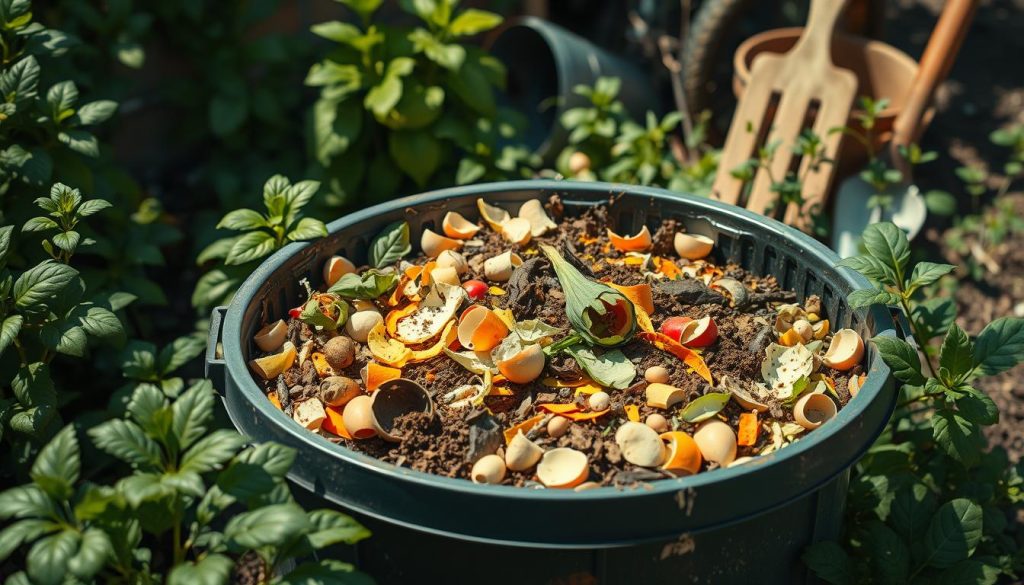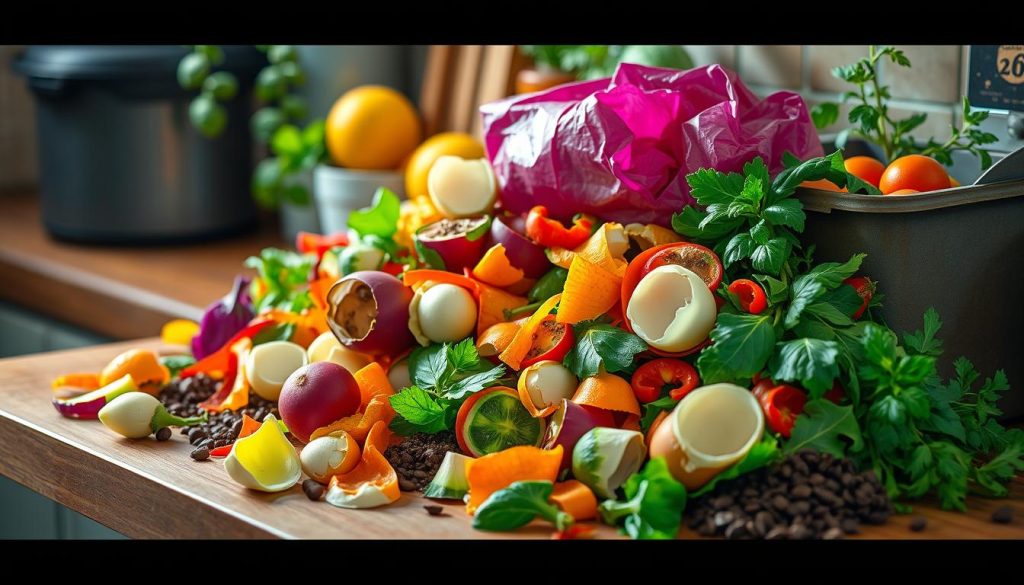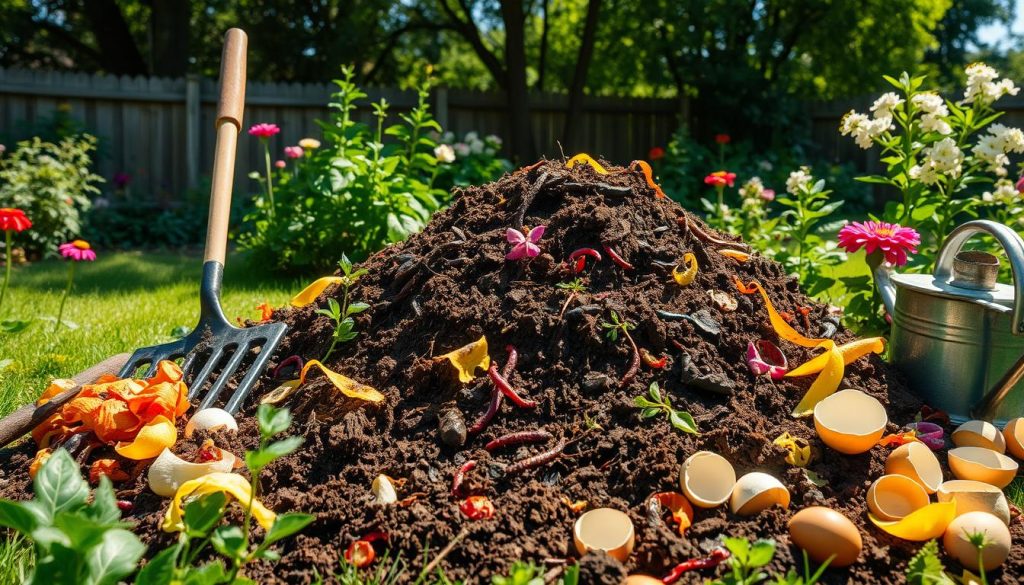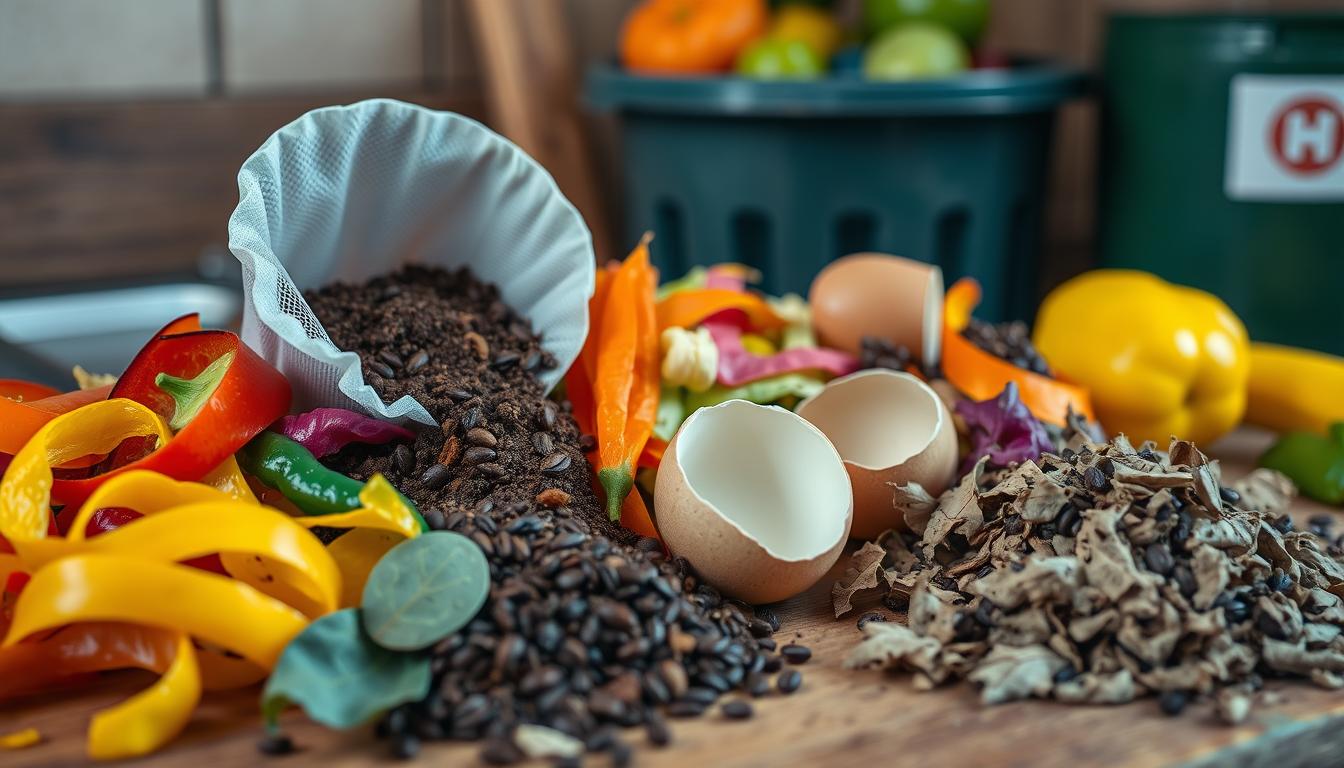I’m excited to share how to reduce waste and make nutrient-rich soil for your garden. By composting at home, you can make your gardening more sustainable. This way, you also cut down on organic waste.
Composting is a great way to lessen waste and make your garden grow. To start, you need to know which kitchen scraps are best for compost. These scraps are full of nutrients. They help reduce landfill waste and make a natural fertilizer for your garden.
In this article, I’ll give you all the key info to make a great compost pile. By following simple tips and using the right kitchen scraps, you can make your gardening more eco-friendly. You’ll enjoy the perks of composting at home, like less waste and better soil.
Understanding Kitchen Scraps and Composting
Kitchen scraps include leftover food waste like fruit and vegetable peels, cores, and rinds. Also, coffee grounds, eggshells, and other organic materials. Composting these scraps helps reduce waste and makes a nutrient-rich soil amendment. It’s a great way to cut down on landfill waste, create natural fertilizer, and fight climate change.
To start composting kitchen scraps, know what can be composted. Some examples are:
- Fruit and vegetable peels and rinds
- Coffee grounds and tea bags
- Eggshells and bread
Following simple tips can turn your food waste into a valuable garden resource. Benefits include:
- Reducing waste sent to landfills
- Creating a natural fertilizer for your garden
- Helping to mitigate climate change
Composting kitchen scraps is a simple, effective way to reduce your environmental impact. It makes your garden more sustainable. By adding compostable food scraps to your compost pile, you create a nutrient-rich soil amendment. This helps your plants grow well.
The Best Kitchen Scraps for Compost
Choosing the right kitchen scraps is key for a great compost pile. The best materials make a big difference in compost quality. Knowing what scraps are good and what you need for a compost bin is important.
Fruits, vegetables, coffee grounds, and eggshells are top choices for compost. They’re full of nutrients and help balance the compost. For instance, fruits and veggies are high in nitrogen. Coffee grounds and filters add carbon. Eggshells bring calcium and can lower acidity.
Fruits and Vegetables
Fruits and veggies are great for compost because they’re full of nutrients. You can compost apple cores, banana peels, and carrot tops.
Coffee Grounds and Filters
Coffee grounds and filters are also excellent for compost. They’re rich in carbon and balance out the nitrogen from fruits and veggies. Plus, they can make the soil better.

Eggshells
Eggshells are a fantastic addition to compost. They add calcium and can lower acidity. They also improve soil structure and fertility.
Adding these scraps to your compost can make it rich and beneficial for your garden. Make sure to mix carbon and nitrogen-rich materials well. Don’t forget to keep your compost bin aerated, moist, and balanced.
What to Avoid When Composting
Exploring composting, I found not all kitchen scraps are good for it. Composting helps reduce waste, but some items should be skipped. Knowing what not to compost helps make a healthy compost pile. This benefits my garden and the environment.
Composting requires knowing what to avoid. Here are common mistakes to steer clear of:
- Dairy products: They attract pests and cause bad smells in your compost.
- Grease and oil: They slow down composting and can harm beneficial microbes.
- Processed foods: They often have additives that can harm your compost and the environment.
Avoiding these mistakes keeps my compost pile healthy. Composting kitchen leftovers reduces waste and makes rich soil for my garden. Following these tips helps me positively impact the environment and enjoy sustainable gardening.
The Benefits of Composting Kitchen Scraps
Composting kitchen scraps is a simple way to cut down on waste. It also makes a nutrient-rich soil amendment for your garden. By using sustainable gardening practices, you can make your soil healthier. This leads to better plants and a more vibrant garden. Choosing the right compost materials is key to achieving this.
Enhancing Soil Fertility
Composting adds vital nutrients to the soil, making it better for plants. It also improves the soil’s structure and fertility. This supports the growth of good microorganisms. They help break down organic matter and fight plant diseases.
Some top materials for composting include fruit and vegetable peels, coffee grounds, and eggshells. These help make the soil more fertile.
Reducing Landfill Waste
Composting kitchen scraps also cuts down on landfill waste. By not sending organic materials to landfills, we reduce methane production. Methane is a strong greenhouse gas.
This action helps our environment and fights climate change. Here are some tips to reduce landfill waste through composting:
- Collecting kitchen scraps in a designated bin
- Adding a mix of “green” and “brown” materials to the compost pile
- Regularly turning the compost pile to ensure aeration and speed up decomposition

How to Start My Compost Bin
To start composting, you need to set up your bin right. Choose the right bin and layer kitchen scraps to help them break down. Start small and be consistent for a successful compost pile.
When picking a compost bin, think about your yard size and kitchen scraps. A big bin is good for large families or big gardens. But, a small bin works well for apartments or small spaces.
Choosing the Right Bin
Popular bins include plastic, wooden pallets, or wire mesh. Each has its own benefits. Plastic bins are easy to clean, while wooden pallets offer good air and can be customized.
Layering Kitchen Scraps
To make a healthy compost pile, layer kitchen scraps correctly. Start with brown materials like leaves or twigs. Then add green materials like food scraps or grass clippings. Keep alternating, ending with brown materials on top. This balance ensures your compost stays healthy and productive.
Maintaining My Compost Pile
To keep my compost pile thriving, I need to ensure it’s well-maintained. This involves regular checks on aeration and moisture levels. By doing so, I can create an ideal environment for compostable food scraps to break down.
Proper aeration is crucial, as it allows oxygen to reach the microorganisms that decompose the organic matter. I can achieve this by turning the compost pile regularly or adding bulking agents like straw or shredded newspaper. This helps to speed up the decomposition process and prevents unpleasant odors.
The Importance of Aeration
Aeration plays a significant role in maintaining a healthy compost pile. Without it, the pile can become anaerobic, leading to the production of methane and other harmful gases. By ensuring adequate aeration, I can reduce the risk of these issues and create a nutrient-rich compost that’s perfect for my garden.

Moisture Levels
Moisture levels are also critical in composting. The compost pile should be kept moist, like a damp sponge, to facilitate the breakdown of organic matter. I can check the moisture levels by squeezing a handful of the compost material; if it’s too dry, I add some water, and if it’s too wet, I add some dry materials like straw or shredded newspaper.
By following these simple maintenance tips and using compostable food scraps, I can reduce food waste at home and create a valuable resource for my garden. This not only helps to minimize my environmental impact but also provides me with a natural and sustainable way to fertilize my plants.
Troubleshooting Common Compost Problems
Even with the best plans, composting can face challenges. Odor problems often mean too much nitrogen. To solve this, I add more carbon-rich materials like leaves or straw. This helps balance the pile.
Pest infestations are another issue. To prevent them, I cover the pile and avoid adding meat and dairy scraps. This keeps pests away.
Choosing the right kitchen scraps is key to a healthy pile. I add organic waste like fruit and vegetable peels, tea bags, and coffee grounds. These are full of nutrients and help balance the compost.
- Monitor the pile’s temperature and turn it regularly to ensure aeration
- Balance the mix of green and brown materials to avoid odor issues
- Keep the pile covered to prevent pest infestations
By following these steps, I can make a compost pile that’s healthy and productive. It will give me a nutrient-rich soil amendment for my garden.
Using Finished Compost in My Garden
Now that your compost pile is ready, it’s time to use it in your garden. Adding compost is a simple way to make your soil better. It helps your plants grow strong and healthy.
Incorporating Compost into Your Soil
To use compost, mix it into the top few inches of your soil. This spreads the nutrients and organic matter evenly. It helps your plants’ roots grow well and keeps them healthy.
But, be careful not to compact the soil. This can block the compost’s good effects.
Nurturing a Thriving, Compost-Rich Garden
Plants like tomatoes, peppers, leafy greens, and many flowers grow best in compost-rich soil. Using compost in your garden makes it lush and productive. It shows how composting kitchen leftovers can be powerful.

